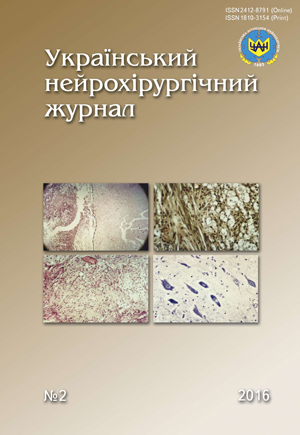Morphologic features of spasmodic adductor femoris muscles in children with cerebral palsy
DOI:
https://doi.org/10.25305/unj.72607Keywords:
cerebral palsy, focal spasticity, adductor femoris muscles, ultrastructural changesAbstract
Purpose. To study ultrastructural morphological changes of spasmodic femoris muscles and their dependence on morbidity terms.
Materials and methods. 12 children with cerebral palsy aged from 2 to 8 years underwent myotomy of adductor femoris muscles and neurotomy of obturator nerve. 2x2 cm pieces of spasmodic adductor femoris muscles were incised during the surgery and provided for further electronic microscopy study. Ultrathin slices (60–70 nm) were proceeded through Reynolds technique and studied under EM-400T.
Results. 3 general ultrastructural features of spasmodic muscles were identified during the study. Mild destructive changes-in children aged from 2 to 4 years, severe destructive changes in children aged from 5 to 6 years, severe outgrowth of connective tissue (muscle fibers were replaced by connective tissue) in children above 6 years of age. The long term presence of spasticity leads to permanent degradation of muscles, replacement of muscle fibers by connective tissue.
Conclusion. 1. Focal adductor femoris muscles spasticity in children with cerebral palsy leads to severe degradation of muscles and even replacement by connective tissue.
2. The severity of morphologic changes in spasmodic muscles depends on morbidity terms.
References
1. Tsymbalyuk VI, Petriv TI. Shkaly v neyrokhirurhiyi [Scale in neurosurgery]. Kiev: Zadruha,2015. Ukrainian.
2. Damulin IV. Postinsul’tnyye rasstroystva: patogeneticheskiye, klinicheskiye i terapevticheskiye aspekty [Post-stroke disorders: pathogenetic, clinical, and therapeutic aspects]. Neurology, neuropsychiatry, Psychosomatics. 2012;2:56-60. Russian. [CrossRef]
3. Ponten EM, Stal PS. Decreased capillarization and a shift to fast myosin heavy chain IIx in the biceps brachii muscle from young adults with spastic paresis. J Neurol Sci. 2007;253(1-2):25-33. [CrossRef]
5. Zinovyeva OE, Katushkina EA, Yakhno NN, Shenkman BS. Izmeneniya skeletnykh myshts pri postinsul’tnoy spastichnosti [The alteration of skeletal muscles in post-stroke spasticity]. Nevrologichesky Zhurnal. 2011;16(4):19-26. Russian.
6. Shamik VB, Tupikov VA, D’yakonova VN. Osobennosti bioelektricheskoy aktivnosti myshts goleni u detey s detskim tserebral’nym paralichom [Peculiarities of shin muscles bioelectric activity in children with infantile cerebral palsy]. Vestnik Travmatologii i Ortopedii im NN Priorova. 2012;(1):61-3. Russian. http://elibrary.ru/item.asp?id=17693670
7. Kushnir GN, Vlasenko SV. Osobennosti diagnostiki i podkhody k terapii bol’nykh detskim tserebral’nym paralichom s tyazhelymi formami dvigatel’nykh rasstroystv [Diagnostics peculiarities, approaches to therapy of patients with infantile cerebral paralysis with heavy forms of motive disorders]. Ukrainian neurological journal. 2008;(2):51-6. Russian.
Downloads
Published
How to Cite
Issue
Section
License
Copyright (c) 2016 Yuriy Lontkovsky, Leonid Pichkur, Victoria Vaslovych, Anna Shmeleva

This work is licensed under a Creative Commons Attribution 4.0 International License.
Ukrainian Neurosurgical Journal abides by the CREATIVE COMMONS copyright rights and permissions for open access journals.
Authors, who are published in this Journal, agree to the following conditions:
1. The authors reserve the right to authorship of the work and pass the first publication right of this work to the Journal under the terms of Creative Commons Attribution License, which allows others to freely distribute the published research with the obligatory reference to the authors of the original work and the first publication of the work in this Journal.
2. The authors have the right to conclude separate supplement agreements that relate to non-exclusive work distribution in the form of which it has been published by the Journal (for example, to upload the work to the online storage of the Journal or publish it as part of a monograph), provided that the reference to the first publication of the work in this Journal is included.









